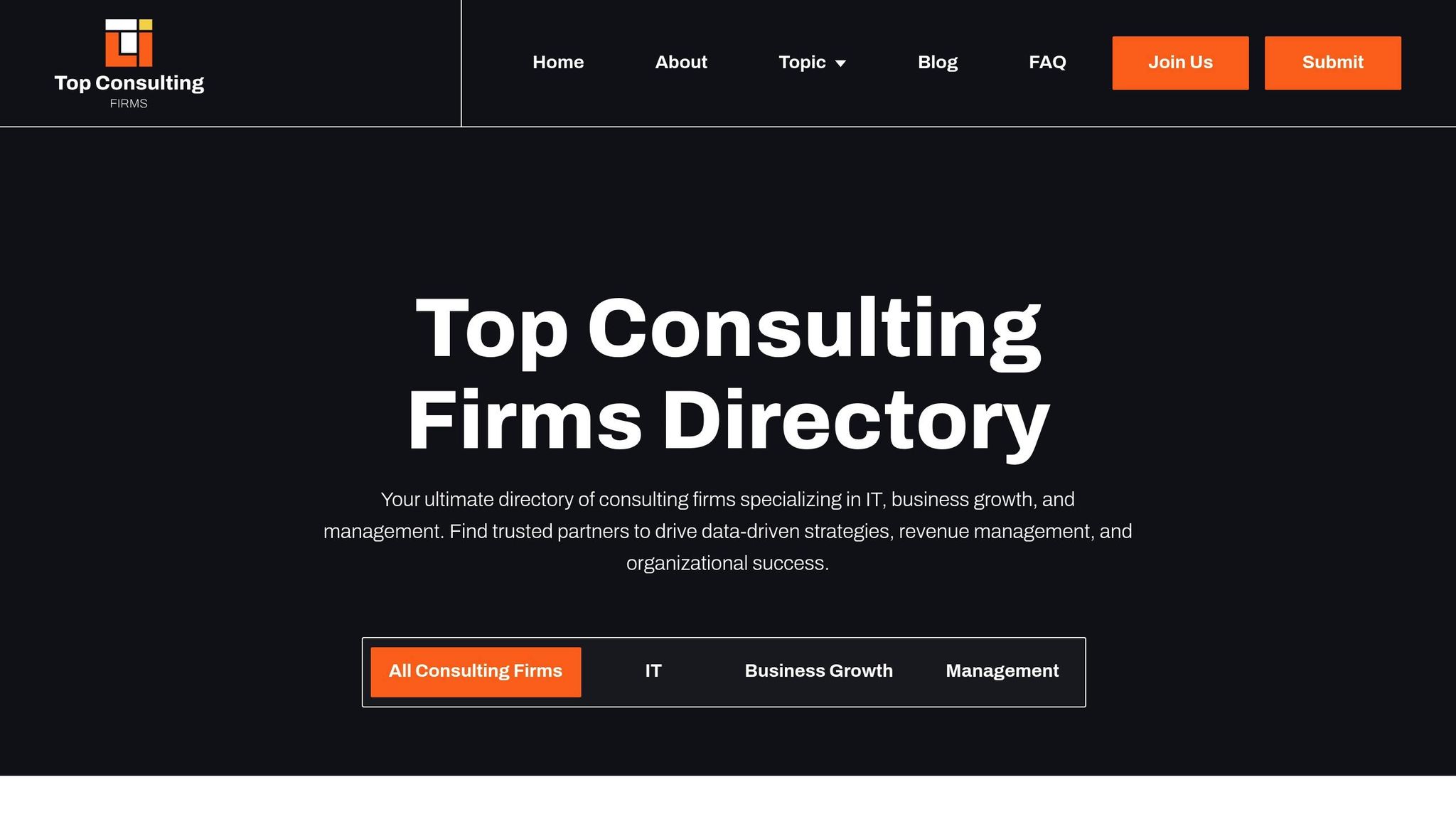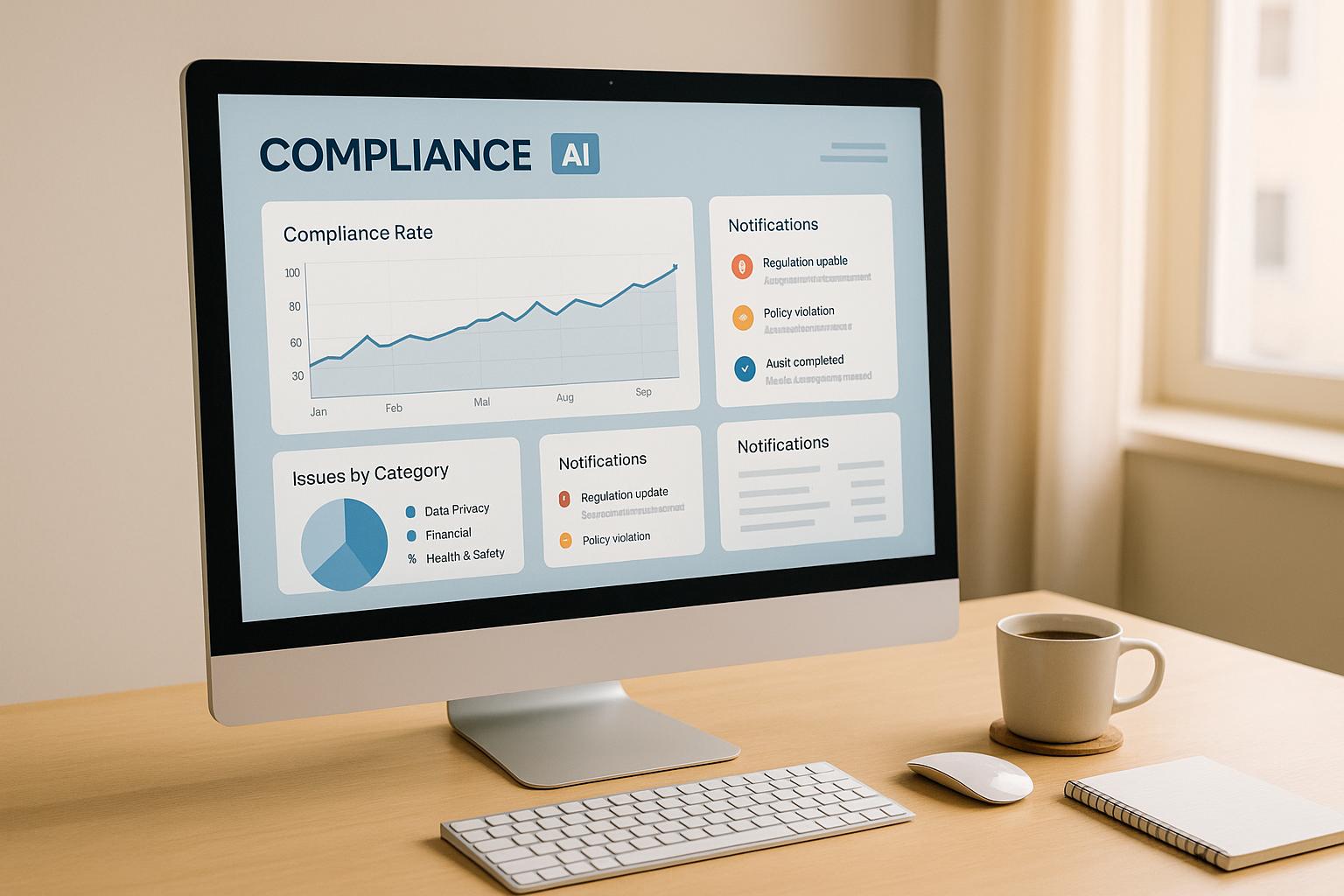Key Performance Indicators (KPIs) are essential for tracking business goals, but when they fail to deliver actionable insights, they can derail decision-making and performance. This guide dives into fixing common KPI issues like poor data quality, irrelevant metrics, or stakeholder misalignment, while also improving their effectiveness through better data practices and advanced analytics.
Key Takeaways:
- Troubleshooting KPIs: Identify issues like inaccurate data, misaligned metrics, or analysis overload, and resolve them with process mapping, data validation, and segmentation analysis.
- Optimizing KPIs: Improve accuracy with automated validation, real-time monitoring, and data governance. Use tools like predictive analytics and machine learning for deeper insights.
- Collaboration Matters: Ensure all teams understand and align with KPIs through training, feedback loops, and tailored dashboards.
- External Expertise: Consider consulting firms to address complex KPI challenges and refine strategies.
By addressing these areas, you can ensure your KPIs remain effective tools for driving better business outcomes.
Overcoming KPI Selection challenges - applying KPI selection techniques
Common KPI Problems and Challenges
Even well-established businesses can encounter KPI-related issues that undermine decision-making over time. These challenges often creep in gradually, making them hard to detect until they’ve already impacted overall performance. Spotting these pitfalls early is essential to ensure KPIs remain a reliable tool for steering business decisions.
Frequent KPI Issues and Their Root Causes
One of the most common challenges is data quality issues. When data collection processes are inefficient, standards are inconsistent, or systems are outdated, the resulting metrics are unreliable. Poorly integrated or unvalidated data sources can lead to conflicting numbers across departments, making it difficult to get a clear and accurate picture of performance.
Misaligned metrics are another frequent problem. This happens when KPIs don’t align directly with an organization’s core goals. It’s easy to fall into the trap of tracking metrics that look important but fail to deliver meaningful results. If a KPI doesn’t have a clear connection to revenue growth or other critical outcomes, it’s likely not serving its intended purpose.
Vanity metrics are particularly troublesome in areas like digital marketing and social media. These metrics often look impressive on the surface but don’t provide actionable insights or contribute to real growth. When teams prioritize boosting numbers - like followers or page views - over improving the quality of their offerings, the strategic value of these metrics diminishes.
Another challenge is analysis paralysis, which occurs when businesses track too many metrics at once. This overload of data can overwhelm teams, dilute focus, and prevent decisive action. When dozens of metrics compete for attention, the "key" in Key Performance Indicators is effectively lost.
Stakeholder disconnect is a major issue when KPIs are unclear, not agreed upon by team leaders, or developed without input from front-line employees. This lack of alignment can lead to misinterpretations and reduced impact, as the people responsible for achieving the goals may not fully understand or support the metrics being used.
Lastly, outdated or static metrics can hinder progress. If KPIs aren’t updated to reflect changing market conditions or strategic priorities, they can provide an incomplete or misleading view of performance. Relying solely on internal or outdated data limits an organization’s ability to adapt and thrive.
How Poor KPI Management Affects Business Results
Flawed KPIs don’t just skew metrics - they can also lead to serious business consequences. One major issue is misguided resource allocation. When decisions are based on inaccurate or irrelevant metrics, organizations may pour resources into areas that don’t contribute to growth while neglecting critical functions that require attention.
Another consequence is decreased employee motivation. Poorly designed KPIs that are easy to manipulate - or that fail to reflect meaningful contributions - can undermine the entire performance management system. When employees can inflate results without delivering real value, productivity and morale take a hit.
Strategic drift is another risk. When KPIs don’t align with an organization’s true objectives, businesses can lose sight of their core goals. Without clear leading indicators to guide them, companies may become reactive rather than proactive, missing opportunities and failing to anticipate changes in the market.
Finally, unintended consequences can arise when poorly chosen KPIs create incentives that harm collaboration or overall performance. For example, focusing too narrowly on individual metrics may encourage behaviors that conflict with broader organizational goals.
These problems can slow growth, increase costs, and hurt profitability. Left unchecked, they become more expensive and harder to resolve over time.
Step-by-Step KPI Troubleshooting Process
To ensure your KPIs stay reliable and effective, it’s crucial to have a clear process for troubleshooting when things go off track. A structured approach helps you identify underlying issues and address them efficiently, so performance gaps don’t linger.
Finding KPI Problems and Gathering Data
The first step is to identify which KPIs are underperforming. Compare current results to historical trends and targets. Watch for sudden drops, unexpected spikes, or metrics that remain flat despite ongoing efforts. Pay close attention to inconsistencies or patterns that don’t align with expectations.
When it comes to data collection, gather information from all relevant sources. Whether it’s Google Analytics, Salesforce, HubSpot, or internal databases, pulling from multiple platforms ensures you don’t overlook critical details. Cross-referencing data can also help uncover discrepancies that might point to quality issues.
Timeline analysis can pinpoint when problems began. Create a performance timeline covering the past 3–6 months and mark major events like product launches, marketing campaigns, system updates, or organizational changes. These markers often reveal connections between events and KPI shifts.
Conversations with stakeholders are equally important. Stakeholder interviews provide context that raw data can’t. For example, sales teams might explain why conversion rates dropped, customer service teams could highlight reasons for lower satisfaction scores, and marketing staff might clarify changes in lead quality. These insights can reveal operational changes or external factors that don’t show up in reports.
Finally, consider benchmark comparisons to put your performance into perspective. If your customer acquisition cost has jumped by 40% but the industry as a whole is experiencing similar increases, the issue may be external rather than internal. Tools like SEMrush, Ahrefs, or industry reports can help you assess this.
Once you’ve gathered all the data, the next step is diagnosing the root causes.
Finding Root Causes and Fixing Issues
After analyzing the data, it’s time to dig deeper into the specific causes of the problem and take action.
Start with process mapping to trace the journey from data collection to the KPI itself. Document every step, including where data originates, how it’s processed, and which systems or people are involved. This can help you uncover bottlenecks, manual errors, or outdated processes that might be skewing results. For instance, if your sales KPIs seem off, follow the trail from lead capture to CRM entry and reporting.
Use data validation techniques to ensure your numbers are trustworthy. Manually verify a sample of records, compare automated calculations to manual ones, and check for duplicate entries, missing data, or formatting errors that could distort results.
Segmentation analysis is another powerful tool. Break down a problematic KPI into smaller components. For example, if your conversion rate has dropped, examine it by traffic source, geographic region, device type, or customer segment. This granular approach often reveals that the issue is isolated to specific areas rather than being a widespread problem.
If you suspect a particular change caused the issue, consider A/B testing and controlled experiments. For example, if a website redesign seems to have impacted conversions, test the previous design with a subset of users to compare results. Similarly, for operational KPIs, pilot a solution with a small team before rolling it out across the organization.
Don’t forget about technical audits. Many KPI problems stem from system-related issues, like broken API connections, missing tracking codes, or incomplete database queries. A thorough technical review can uncover these hidden problems.
Once you’ve identified the root cause, implement solutions strategically. Start with fixes that are easy to execute but have a high impact. For example, if data quality is the problem, introduce validation rules and automated error checks. If the issue lies in misaligned metrics, work with stakeholders to redefine KPIs that better align with business goals. For outdated systems, plan temporary fixes while working on long-term upgrades.
Monitoring and verification is the final step. After implementing changes, set up alerts to flag unusual KPI movements and schedule regular reviews to catch any new issues early. Document the steps you’ve taken and track the outcomes over time. This not only builds a knowledge base for future troubleshooting but also helps prevent similar problems from happening again.
The key to effective KPI troubleshooting is to stay objective. Let the data guide you, even if it points to an unexpected cause. Often, the real issue isn’t what you initially assumed, so being open to new insights is essential.
sbb-itb-97f6a47
How to Optimize KPI Performance
After addressing immediate KPI issues, the next challenge is to build a system that supports long-term improvement. This involves creating processes that not only ensure accuracy but also make your metrics more impactful for decision-making. Here’s how you can refine KPI performance for lasting success.
Improving Data Quality and KPI Accuracy
Accurate KPIs rely on high-quality data. Without reliable data, even the best analytics can lead you astray. The solution lies in automating systems that catch errors before they distort your metrics.
- Automated validation rules act as an early warning system. These rules can flag unusual values, missing entries, or formatting errors. For instance, if your average order value suddenly jumps from $75 to $750, an automated alert can catch this anomaly before it affects reports. Many platforms allow you to configure such rules directly.
- Real-time data monitoring ensures you catch problems as they happen. Set up dashboard alerts to notify you when metrics deviate from expected ranges. For example, if your website's conversion rate usually sits between 2.5% and 3.2%, you could trigger alerts for anything below 2% or above 4%. This proactive approach allows for quick investigations.
- Data governance policies help maintain consistency across teams. Standardize how metrics are calculated, define data sources, and assign responsibility for accuracy. For example, when all teams - sales, marketing, and customer success - use the same definitions for terms like "qualified lead" or "customer lifetime value", your data becomes far more dependable.
- Regular data audits should be part of your routine. Whether monthly or quarterly, audits help you compare automated results with manual checks, verify that data sources are properly integrated, and identify unusual patterns. This process helps catch gradual inaccuracies that might otherwise go unnoticed.
- System integration minimizes manual errors and eliminates data silos. Instead of relying on team members to manually transfer data between platforms, invest in tools like API connections or Zapier. Automated syncing between your CRM, email marketing platform, and accounting software ensures cleaner, more reliable data.
These practices lay the groundwork for more advanced analytics that can take your KPI insights to the next level.
Using Advanced Analytics for Better Insights
Once you’ve established reliable data, advanced analytics can help you uncover actionable insights.
- Predictive analytics transforms your KPIs into tools for forecasting. Instead of just knowing customer churn increased last month, predictive models can identify which customers are likely to churn next month, giving you time to act.
- Machine learning reveals patterns traditional analysis might miss. Tools like Google Analytics Intelligence or Microsoft Power BI’s AI features can identify correlations between metrics and external factors, helping you understand not just what happened, but why - and what could happen next.
- Cohort analysis allows you to dig deeper into customer behavior by grouping users with shared traits. For example, instead of looking at overall retention, examine how retention varies among customers acquired through different channels or during specific time periods. These insights often highlight opportunities that broader metrics might hide.
- Statistical significance testing ensures your KPI changes reflect real trends, not random fluctuations. For instance, before concluding that a new marketing campaign boosted conversion rates, test whether the improvement is statistically meaningful. Tools like Google Optimize or Excel’s statistical functions can help verify your results.
- Benchmarking and competitive analysis provide context for your performance. Platforms like SEMrush or industry reports can show whether your metrics are improving compared to competitors or simply keeping up with market trends.
- Custom dashboards and visualizations make it easier for stakeholders to understand complex data. Tools like Tableau or Google Data Studio can turn raw numbers into clear, compelling visuals that highlight trends and actionable insights.
While technology refines your data, collaboration ensures those insights translate into meaningful actions.
Working with Stakeholders for Better Results
Strong collaboration across teams is essential to turning KPI insights into real-world results. Here’s how to align people with your metrics:
- Cross-functional alignment ensures all teams work toward shared goals. Regular meetings between departments help resolve conflicts, like when marketing’s lead-generation targets don’t align with sales’ conversion goals. Aligning these objectives makes KPIs more actionable and relevant.
- Stakeholder education helps team members understand how their work impacts KPIs. Training sessions that explain the connection between daily tasks and business metrics can boost engagement. When employees see how their efforts influence outcomes, they’re more motivated to contribute.
- Feedback loops create opportunities for ongoing improvement. Organize monthly or quarterly reviews where stakeholders can discuss what’s working, what’s not, and suggest additional metrics that could be helpful.
- Role-based KPI access ensures each team member sees the metrics most relevant to their responsibilities. For example, sales managers need different dashboards than customer service reps or executives. Tailored access reduces information overload and helps teams focus on what they can directly influence.
- Change management processes make it easier to adapt when KPIs need updating. Before introducing new metrics, explain the reasoning behind the change, provide training, and address any questions. This approach ensures smoother transitions and greater buy-in.
- Recognition and accountability systems reinforce the importance of KPIs. Celebrate teams or individuals who meet or exceed their targets, and address underperformance constructively. When KPIs carry real consequences - both rewards and accountability - they become more than just numbers on a screen.
Using Consulting Expertise for KPI Success
While your team may work hard to refine KPIs internally, sometimes bringing in external expertise can take your performance to the next level. When daily operations stretch your internal resources thin, consultants can step in to provide a fresh perspective. Their outside viewpoint, paired with experience across various industries, helps pinpoint ways to improve how you measure success and ensure your KPIs stay aligned with your larger business goals.
Why Consider External Consulting for KPI Optimization
External consultants bring a unique advantage: they offer an objective assessment and specialized expertise that complements what your internal team already does. By drawing on their experience working with diverse industries, they can uncover gaps in your current measurement processes and suggest proven techniques to improve them. This outside input can breathe new life into your KPI strategy, ensuring your goals are both relevant and achievable.
How the Top Consulting Firms Directory Can Help

The Top Consulting Firms Directory is a valuable resource for businesses looking to partner with experienced consultants in areas like IT, business growth, and strategic management. This platform makes it easy to compare firms based on their expertise, past performance, and how well they align with your company’s needs.
With this curated directory, you can evaluate consulting firms that specialize in areas like digital transformation and revenue growth. By choosing the right partner, you’ll be better equipped to align your KPIs with your business objectives, combining external insights with your internal strengths for long-term success.
Conclusion: Better Business Results Through Smart KPI Management
Managing KPIs effectively isn't a one-and-done task - it demands consistent attention, problem-solving, and fine-tuning. The companies that thrive are those that view their KPIs as evolving tools, ready to shift with the ever-changing business landscape.
The first step in solid KPI management is spotting and addressing issues early on. Regularly monitoring your metrics allows you to catch small problems before they snowball into major setbacks. This kind of proactive mindset keeps your decisions grounded in reliable data, giving you a competitive edge.
Refining your data processes can take your KPIs to the next level. By improving data quality, leveraging advanced analytics, and ensuring your metrics align with your business priorities, you create a system that drives action and results. The trick is finding the sweet spot - having enough data to guide decisions without overwhelming your team with unnecessary complexity. This ongoing effort ties your strategic goals to real-world execution, ensuring every move you make is intentional and impactful.
Getting everyone on the same page is just as important. When your team understands what the metrics mean, why they matter, and how their roles influence those numbers, your organization operates with a shared purpose. This alignment turns raw data into actionable insights that propel your business forward.
Sometimes, internal resources can only take you so far. That's where outside expertise comes in. Consulting firms, like those featured in the Top Consulting Firms Directory, can bring fresh perspectives and specialized knowledge to fine-tune your KPI system and help you achieve measurable results.
Ultimately, your KPIs should serve as tools to help you, not obstacles in your way. By applying these strategies, you'll make better decisions, identify opportunities faster, and drive better business outcomes.
FAQs
How can businesses make sure their KPIs stay aligned with changing strategic goals?
To keep KPIs in sync with shifting strategic goals, businesses need to consistently review and adjust their metrics to reflect current priorities and market dynamics. This involves collaborating with key stakeholders, analyzing performance data, and fine-tuning KPIs to zero in on the factors that truly impact outcomes.
Regularly reassessing and refining KPIs helps companies ensure their metrics stay relevant, align with their latest objectives, and drive progress toward sustained success.
How can businesses improve data quality to ensure more accurate KPIs?
Enhancing data quality is key to ensuring your KPIs are accurate and reliable. Start by leveraging advanced data management tools to automate tasks like validation and cleansing. These tools can help streamline processes and reduce the risk of errors. At the same time, foster a workplace culture where employees take ownership of data accuracy. Real-time monitoring systems are also a must - they allow you to quickly spot and address issues as they occur.
Consistently auditing your data for accuracy, completeness, consistency, and timeliness is another crucial step. This proactive approach helps you catch potential problems before they escalate. Additionally, standardizing data formats, performing routine error checks, and offering ongoing training to your team can go a long way in maintaining data quality. Together, these strategies ensure your KPIs are built on a solid foundation of trustworthy data.
When should a business hire external consultants to improve KPIs, and what value do they provide?
When businesses face intricate challenges, lack the necessary in-house expertise, or are gearing up for major strategic shifts, bringing in external consultants for KPI optimization can be a smart move. This approach is particularly helpful when internal teams struggle to tackle these hurdles effectively or when a fresh, unbiased perspective is needed.
External consultants bring deep expertise, fresh perspectives, and practical solutions to the table. They assist in pinpointing performance bottlenecks, refining processes, and ensuring KPIs align seamlessly with overarching business objectives. With their experience, companies can achieve quicker outcomes, avoid costly missteps, and sharpen their competitive standing in the market.


